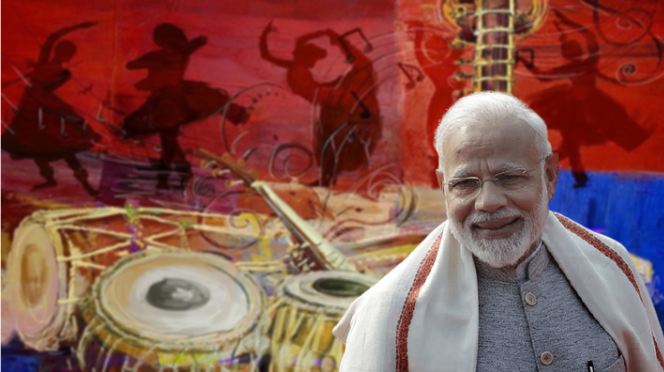India is the only country that recognises the voice as the first and most important musical instrument. There is no other tradition in the world, where the voice of a person has such significance. Now, there are no “good” or “bad” voices. With training, everyone can become a musician.
Again, no other civilisation places as much emphasis on training for music as India does. Of course, what we know as “Indian classical music” today is inherent to all of Southeast Asia, since this genre of music – which is the greatest and most superior in the world – owes its roots to the sacred Vedas.
But Indian classical music is facing a crisis. Today, classical music has little to no takers among the Indian youth. There are always a few exceptions here and there, but the present generation has not only lost touch with classical music but has also enshrined in its heart an unflagging love for Western music.
I am, of course, referring to the English-speaking folks here. Non-English speakers find solace in Bollywood noise productions, which frankly, are abominations in the name of music.
Indian classical music traces its roots to the Samveda. The hymns of Samaveda contain melodic content, form, rhythm and metric organization. The Rigveda embeds the musical meter too, however, not in as detailed a manner as the Samveda does. The classic Sanskrit text Natyashastra is at the core of the numerous classical music and dance traditions of the Indian subcontinent.
Classical music of the north is called ‘Hindustani’ music, while the kind prevalent south of the Vindhyas is called ‘Carnatic’ music. Now, here’s where things get exciting. Music around the world traces its origins to the Indian civilisation. The seven notes of music “Sa Re Ga Ma Pa Dha Ni” have, for the rest of the world, become “Do Re Mi Fa So La Ti”. So, music around the world is today inspired by India. Yet, Indian classical music is struggling as a genre.
PM Modi’s Push to Revive Classical Music
Prime Minister Narendra Modi has stepped up and sounded the bugle for Indian classical music to be revived, and not just revived, but taken across the world. Speaking at an online event organised for launching the Pandit Jasraj Cultural Foundation on the 92nd birth anniversary of the classical vocalist, PM Modi made a call for popularizing Indian music on a global scale.
The Prime Minister has urged people to infuse technology in music and set up music-based startups. He said, “My request to the cultural foundation is that it should focus on two things specifically. We hear about globalisation but its definitions and talk surrounding it are centred around the economy. In today’s times of globalisation, it is our responsibility that Indian music makes its mark and has an influence globally.”
The Prime Minister also said, “Indian music has the capacity to revolutionise the depth of the human mind. It also strengthens the experience of the oneness of nature and the divine.”
Why Classical Music Must be Celebrated
Indian classical is the greatest music genre in the world. No other genre of music comes miles close to the intricate and comprehensive Indian music system. Indian classical singers can sing practically anything from around the world. However, no international artist can perform a semi-decent classical piece without extensive practise and devotion. That is how difficult and awe-inspiring classical music is.
The likes of Pandit Bhimsen Joshi, Pandit Jasraj, Pandit Ravi Shankar, Hariprasad Chaurasia, Shivkumar Sharma, among others are artists who are simply undefeatable in the world of music. Many of the renowned western singers, musicians and rappers will be all stunned into silence when they will hear the works of such artists.
Read more: From “Rehna hai Tere Dil Mein” to “Kanta laga Uii Maa Oooh” – The fall of Indian Music
The tragedy of classical music in India is that it is fast losing an audience. Bollywood is producing one trashy song after the other – corrupted with Urdu insertions and replete with vulgarity. Sadly, such noise finds hordes of takers across the country, while a supreme musical genre continues to languish in anonymity. It is for this reason that Prime Minister Modi’s call to infuse classical music with technology – while preserving the art can have a dramatic effect in popularizing the genre to Indian masses.
No art comes close to Indian classical music. Therefore, the need of the hour is to embrace this genre of spectacular music and make it ‘cool’ to listen to. The sentiment, when listening to classical music, must be that of celebrating Indian culture in its purest form. Not only is classical music highly addictive, but it can also prove to be healing for many. Why so? Because there is an entire science at work behind classical music.
Hindustani music exists in four major forms: Dhrupad, Khyal (or Khayal), Tarana, and the semi-classical Thumri. Dhrupad is ancient, Khyal evolved from it, Thumri evolved from Khyal. Khyal is the modern form of Hindustani music, and the term means “imagination”. Dhrupad is the ancient form described in Natyashastra and is one of the core forms of classical music found all over the Indian subcontinent. The word comes from ‘Dhruva’ which means immovable and permanent.
Indian classical music, therefore, is not just a genre. It encompasses several genres within itself. In Indian classical music, the raga and the tala are two foundational elements. The raga forms the fabric of a melodic structure, and the tala keeps the time cycle. Both raga and tala are open frameworks for creativity and allow a very large number of possibilities.
Today, many classical artists can soothe the ears and souls of Indians. Some of them include Ajoy Chakraborty, Kaushiki Chakraborty, Shankar Mahadevan, Rashid Khan, among others. If you don’t believe me in my extollation of Indian classical music, watch any one of Kaushiki Chakraborty’s performances and you will realise how great of an art Indian classical music is.
India can export its treasure of music around the world. Classical music can become India’s biggest soft power flex, much like Yoga. But for that to happen, Indians must first embrace classical music themselves.
































Carnatic music?????? Names???
The classical music of south India is also derived from the Sama & RigVeda and is called Carnatic music and is much more challenging and difficult to master. We are sure Indian music lovers in India and all over the world are familiar with the vast influence of the music of Bharatha Ratna M S Subbulakshmi and Dr. Balamurali Krishna, along with a host of senior and sub senior musicians. The sad story is that there is no Govt support or assistance for the large number of young musians to take Music as. Profession. Added to this, the only organisation supporting classical music, Prasara Bharathi, has showed scant respect for classical music by merging the the channels broadcasting classical music in to the Raga Channel, there by curtailing the only outlet the young musicians had to popularise classical music. Our fervent appeal to our respected Prime Minister is to order Orasara Bharathi to bring back channels like Amrita Varshini in Karnataka and hold music auditions for young music aspirants, so that our great heritage of classical music is fostered for the future generations of India.